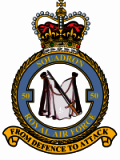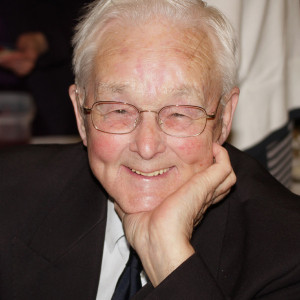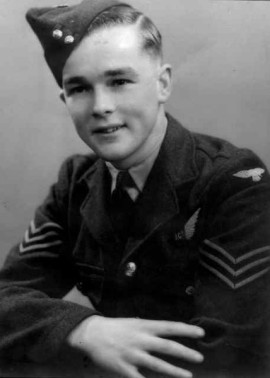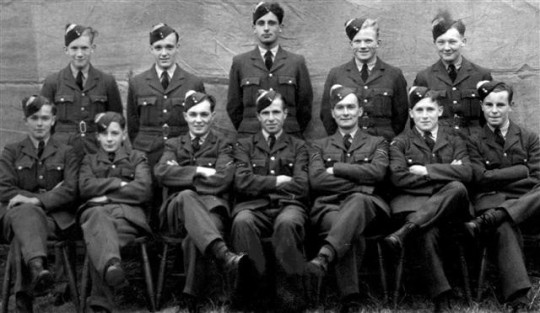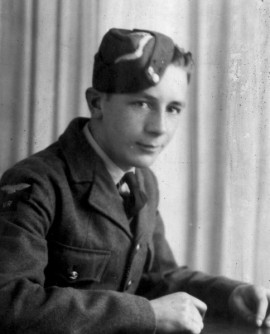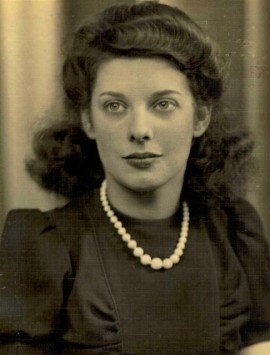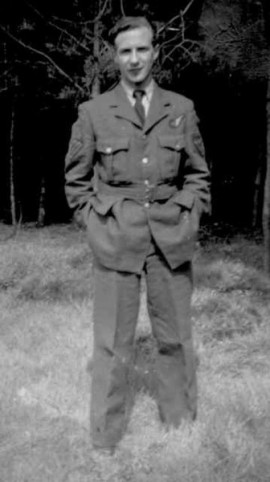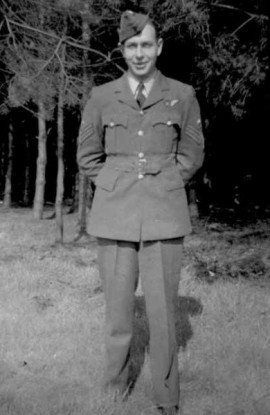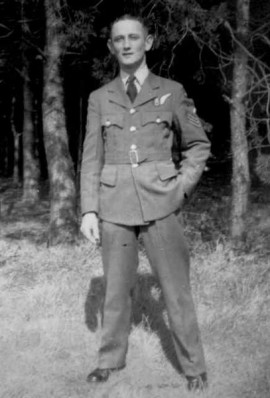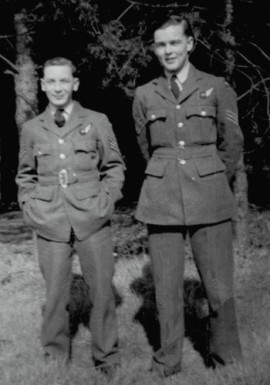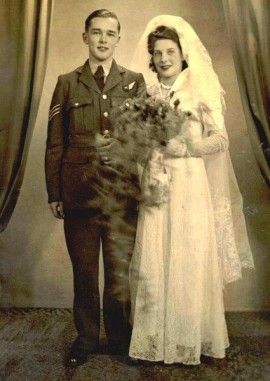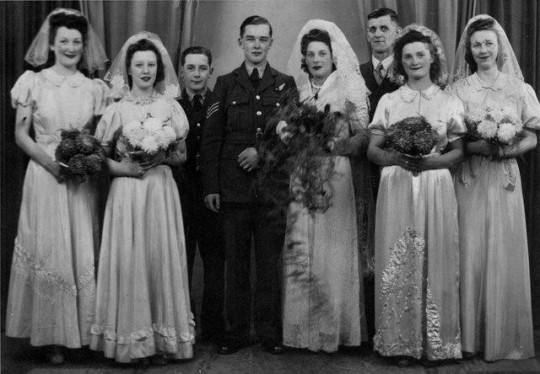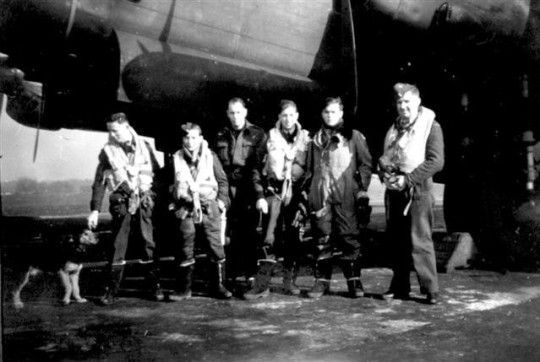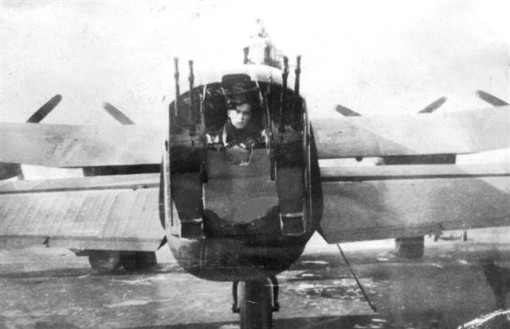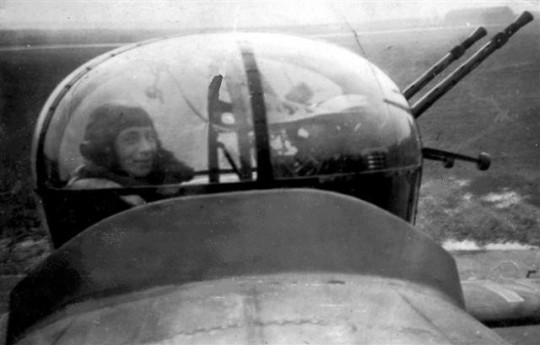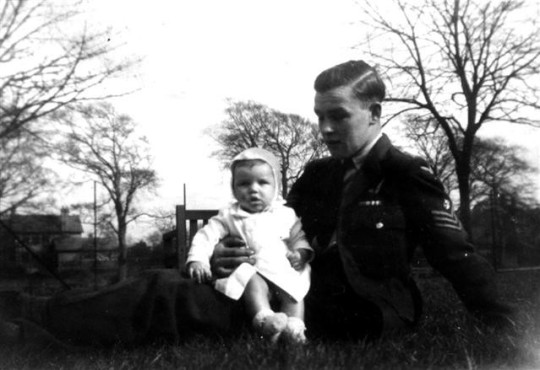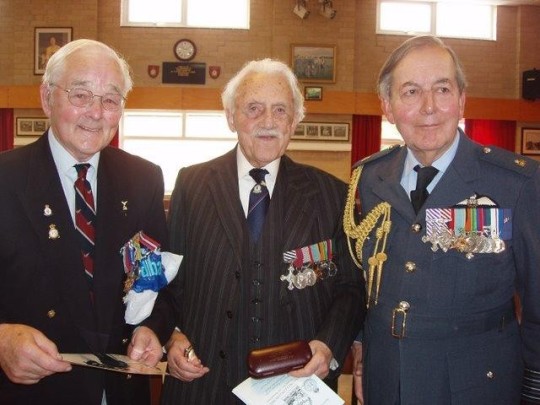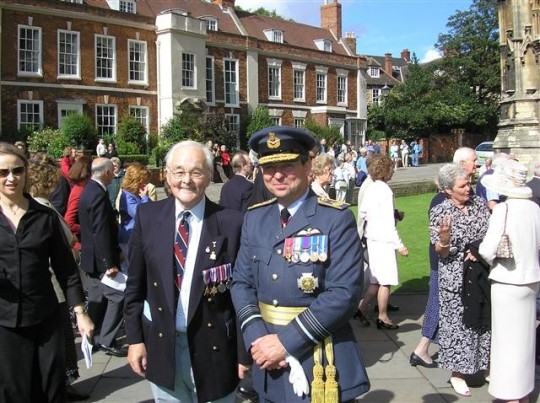Flight Sergeant H James Flowers
Below: 1944. Sgt H.J.Flowers. Service number: 1819544.
A Tail End Charlie's story:
Henry J.Flowers and I joined the RAF on the 6th of March 1944 at the Aircrew Induction Centre, Lords Cricket Ground, London. When the name H.J.Flowers was called out we both stepped forward. We struck it off immediately, instantly becoming friends. After kitting out we were all moved to St John's Woods for medicals and inoculations. With the Germans having renewed their blitz of London, we spent a number of nights squatting on the stairs listening to bombs being dropped. Two weeks later as I looked out of the window of the train which was taking us to RAF Bridgenorth for basic training, the tremendous bomb damage done by these bombers over several years made me ready to return the compliment.
From there we moved to RAF Stormey Down, South Wales for Air Gunner Training.
June 1944 Air Gunner Training. RAF Stormey Down. Front Row: lst James. 2nd Henry.
The photograph above was taken by Jack, the Nav. just before we climbed aboard VN-K for the trip to Bohlem.
OTU, returning from a training raid, couldn't find airfield. Only thimble full of fuel left as we finally landed.
HCU, Bail out instructions
given, I climbed out of rear turret to standing position, then hanging on with one hand began to take off helmet, it was then that I heard “don't bale out” shout.
Green as grass I was at the time.
HCU, In Stirling, made emergency
landing at RAF Woodhall Spa, aircraft swung off runway finally stopping with nose of aircaft only a few feet away from control tower. Skip called control “can you see where we are”,
dry reply “YESSSS”
On one occasion whilst corkscrewing,
all 4 Stirling engines cut out. Skip immediately slammed the aircraft into a vertical dive to kick start them back to life.
That made the heart throb a bit.
5th March 1945. Night op to Bohlem
Germany. 10 hrs trip.
Approx 2hrs after take off, pitch dark, as I watched the engine sparks of a Lanc gently drift from port underneath us their was a tremendous explosion just behind, two Lancs had collided, the large flash of light then split apart seconds later there were two big flashes as both aircraft blew up nearly taking us down.
Sadly I realised that 14 airmen had just lost their lives.
Those unseen bombers now seemed very menacing.
At 12,000ft with a moonlit sky, the 10-10th white clouds at 10,000ft seemed like a rolling sea. Suddenly to our starboard rear a small dot appeared from the
clouds. It looked for all the world like a fly. “It's a fighter, It's a fighter”. I thought. As I watched intently I made through inexperience. what could have been a fatal mistake.
I ought to have immediately warned the rest of my crew. Nevertheless, I trained my guns on the object as it slowly gained height, moving to a position dead astern of me. Now, with my
gun sight filled it had reached firing range, at that moment the hours spent in training viewing silhouettes of all types of aircraft paid off as I recognised an ME109. Pressing my firing button I
fired a prolonged burst, immediately my four 303 machine-guns began rattling away as I watched their tracer bullets fly straight into the enemy fighter, instantly, as if out of control, it dived
vertically into
10-10th cloud some 2,000 ft beneath us. “Got him” I thought. (Back at base I claimed a probable.)
Much later as we neared our target another ME 109 made a run at us, this time I didn't wait, immediately pressing the firing button in the middle of my controls. Calamity!!! my gun-sight fell apart filling my turret with a bright light and blinding me in the process. It took seconds to put it together but 20 minutes for my night vision to return, during that time large spots in my eyes prevented me from seeing anything outside.
To this day I have no knowledge of what happened to that fighter.
As we arrived back over the almost intertwined circuits of Skellingthorpe, Waddington and
Scampton I was desperately tired, nevertheless, knowing that the black sky around me was hiding many other tired crews, along with the knowledge that enemy fighters had shot down
three Lancasters in the Waddington circuit the previous night, I remained on full alert. This time instead of relaxing as we entered the Skellingthorpe circuit I remained on full alert searching the
full sky in anticipation of possible intruders. How relieved I was after our engines had been shut down in dispersal. Only 30 more to go.
“Must do better if I'm going to survive.” I thought.
Almost immediately a notice appeared on the 50 squadron notice board March, 1945. As far as I can
remember this was what was written:
BOMBER
COMMAND NOTICE
WARNING, 40 AIRCRAFT HAVE BEEN SHOT DOWN IN CIRCUITS
DURING THE LAST MONTH. GUNNERS ARE WARNED THAT THEY MUST
REMAIN ON FULL ALERT DURING COMPLETE
LANDINGS.
Sadly
this warning came to late save the lives of three crews landing at
Waddington and another at Fulbeck
..............................
My 4th Op 14/15 March 1945.
To Lutzkendorf, Germany.
10 hrs night op.
3 Group attacking Ruhr as we flew past.
Tremendous flak bursts kept appearing. Air to air tracers were seen warning that enemy night fighters up in force. What a scrap our bombers and enemy defences were having, and we still had another 2
hrs flying to reach our target. “Hmm Something to really look forward to” I
thought.
After flying for around 5 hours we at last neared our target. Suddenly RT silence was broken, “controller to link one, how do you read me”, it was the voice of Wing Commander Stubbs. He could have been over the UK as he calmly gave instruction to the Pathfinders and then to the Bomber Force. After finishing giving instructions he then exclaimed “you see there is no flak, watch out for fighters, watch out for fighters”.
Now on our bombing run I listened to our B/A's instructions to Skip, “left, left steady, right a bit” and so on. His voice seemed to be droning on for ever, I remember thinking to myself “get on with it, drop them, lets get out of here”. Finally he called “bombs gone”. 12 seconds later he called out “photos taken”. Skip immediately dipped the aircraft nose down and sped away from the target area. “Got away with it” I thought.
Little did I know.
Long after we had left the target I could still hear the controller calmly giving instructions ie,
“undershoot the red marker, overshoot it two seconds” and so on. His calm manner was inspiring.
Suddenly, with the sky pitch black, a Fighter flare burst directly above us. The shock made me sink deep in my seat. My mind now began to work like lightening as I knew
that somewhere out there a fighter would be attacking. Fully focused I quickly searched the sky all around, sure enough there was a FW 190 coming in fast from high on the starboard beam. No time to
aim properly, “fire fire” I thought. Immediately my 4 machine guns began rattling away as I watched their tracers bullets flying towards the 190. It was then that in my right
eye, I felt rather than saw, a movement deep down on the port side, forcing myself to look away from the 190 I was horrified to see a JU 88 almost underneath us. this twin engined fighter was now the
greatest danger as I knew that it would have upwards firing guns and that it would shoot us to pieces if it managed to get underneath. Jamming my controls hard right I swung my turret as fast as I
could to port, firing as soon as I could. Both aircraft immediately broke away. The
two enemy fighters then played cat and mouse with us for what seemed hours, “Corkscrew port, Corkscrew starboard” I kept calling as the two fighters flew in and out making determined
efforts to shoot us down. The G force on me was terrific. My adrenaline was through the roof as I tried hard to see them early enough to ward them off. With Lancaster's having no power assisted
controls the effort required by Skip to continuously corkscrew must have been enormous. During the action we lost 5,000ft.
In his report our navigator recorded the full combat as lasting 26 minutes. Considering that the average attack lasted no more than 10 seconds, this was a tremendously long time to be under attack. How wonderful it was to once again cross safely over the coast of England.
Back at base I was to find out that I had used all 10,000 rounds supplied to the rear turret.
Another attack and we would have been goners. Phew!!!
I am certain that the reason why I was able to see the enemy fighters early and able to force them to break away was because all the perspex infront of me had been taken out, this gave me a completely clear picture of the sky behind. A much better one than I would have had looking through perspex. Boy it was cold, nevertheless I never complained as I knew the uninterrupted view saved my life several times.
4th April 1945. Daylight
op to Nauhausen.
Bomber Force meeting point over Reading. Early morning take off meant that it
was still dark as we skirted the London area. Hundreds of search lights where shining over London. I was on tenterhook as I looked down at the scene as we had been told at briefing to be careful not
to stray into this area, apparently London ack-ack gunners were known to have very itchy fingers if any aircraft strayed over them. Suddenly Skip threw the aircraft into a vertical dive, at the
same time my head received a painful blow as the G. force stretched me upwards to the turret ceiling. At that moment a Lancaster passed directly over my turret. I swear it was so close that I
could have reached out and touched it's belly.
Another one of our 9 lives gone.
The sun was shining brightly as we flew south towards our target. Suddenly RT silence was broken by a furious Fighter Escort Leader, “Close up, close up, how do you expect me to protect you” Despite the worries of the Fighter Escort Leader we did arrive safely at the target. Quickly Bombers began to crowd together as they approached their bombing run. I'm certain our Fighter Escort Leader was pleased by that, I wasn't. Hundreds of bombers now began to draw together in long thin line. It was getting very hairy. I didn't mind those behind or by our side. Those above that I could see were also OK as I knew our forward speed would take us away from their falling bombs. It was those ahead above that worried me. Sure enough my worries were confirmed as a load of bombs fell past my turret literally inches away. I was only a whisker away from extinction. Following their flight down I saw the first two l,000 pounders hit a Lancaster, some 50 ft below us. The lst. struck the fuselage just to the rear of the mid-upper-turret. I cringed expecting it to explode. This would have certainly taken us out (no-doubt delayed action fuses saving the day) Unbelievably the bomb smashed through it's fuselage and disappeared downwards. The 2nd bomb hit the middle of it's port wing, once again I couldn't believe my eyes as I watched it bounce backwards off the wing and drop away. Last but not least was the 4,000lbs Cookie, it missed it's port wing by a skin of paint. As Cookie's were contact bombs it would have definitely exploded on contact. Certainly hair curling stuff.
As I watched the stricken bomber finally swung starboard out of my sight.
…....................................
Listening to a radio program after the end of the WW11 in which a Canadian pilot, on the gang plank of a returning ship, was asked if he could relate any interesting story to the listeners, his reply “yes” he then went on to say that during a daylight operation his aircraft was struck by bombs from above, one went straight through the fuselage, a second hit the port wing and bounced off and that a Cookie missed by inches. He was obviously the pilot of the aircraft I have just written about. He went on to say that they had managed to return home safely dropping their bombs in the North Sea. He also went on to say that all his crew had survived the war. Lucky them.
….........................................
Another interesting incident occurred later over the North Sea. From about 10,000ft I saw two Lancaster's suddenly drop down to zero feet, “Gosh, someone is in
trouble”.I thought. Watching intently I suddenly saw foam appear from behind the engines of one. It was like watching a racing boat at full speed. this continued for around 400
yards after which the foam disappeared and both aircraft regained a little height. Once again I was to find out later what
really happened.
….......................................
A short time later we made a landing at RAF Spilsby. Able to leave our aircraft for a stroll I was intrigued by the sight of a Lancaster with all it's propeller blades badly bent. “What happened to that” I asked a member of ground staff working on it, laughingly he said “returning from a recent daylight the pilot of this one and another were playing about trying to find out who could fly closest to the sea. The pilot of this one ran his props in the water, nearly drowned the rear gunner. Silly fool ”. He then went on to say that both pilots were being court martialled for hazarding their aircraft. “Gosh “,I thought, “ it must have been a nightmare keeping her flying with such damage. Maybe they lived to regret their tomfoolery.”.
….............................................
14th April 1945. Daylight op to Hamburg.
57 bombers. 617 and 9 carrying Tallboys
to bomb Submarine Pens. 50 and 61 in support carrying 1,000 pounders to bomb Fuel depots.
Flak at the target was so heavy you could have walked on it. Unbelievably we got through undamaged. A short time after leaving the target 25 ME262 jet fighters attacked
the bomber force. We where at the rear of the gaggle. “Skip”, I called, “ I can see 5 small fighters at ground level. Gosh I've never seen fighters travelling so fast. Gosh they are climbing
faster than I've ever seen any fighter dive”. In seconds they reached our height, levelled out and then flew straight at us with all cannons blazing. One flew straight at us as I fired
continuously at it. Just when I thought it would ram us it swung starboard in-between our aircraft and another Lanc. Frantically I let go of my controls as I saw tracers flying straight
at this other bomber. ( I've often wondered what would have been said if I had shot down one of our aircraft, especially as I then realised that it was one of 617 sqdn.
aircraft).
Suddenly the back marker aircraft exploded, broke in half and began to fall vertically down. When it had fallen about a 1,000ft I saw the rear gunner (a friend) drag open his turret doors and fall out backwards. To my relief his parachute immediately opened, “great he's going to make it,” I thought tragically it suddenly exploded in flames. Burning aviation fuel no-doubt the cause. I then had to sit and watch my friend, F/Sgt Norman Lewis Garfield Felton fall struggling to his death. So sad.
That day, after briefing, we sat together in the aircrew bus as we travelled to our aircraft in dispersal. With still on hour to go before take off , after making our pre-op checks we climbed out of our respective aircraft and sat on the grass, chatting away as we enjoyed the morning sun.
The next two incidents below occurred after VE day, whilst I was serving with 44 squadron in Tiger
Force
6th June 1945. RAF
Spilsby.
Task- to drop 14,000lbs of incendiary bombs in the North Sea dispersal area. As we taxied along the perimeter track one of our port engines set on fire. Smoke pothered into my rear turret. The engine was feathered. Skip informed Flying Control what had happened and then asked for instructions. After a short time FC informed us “start the engine up, give it a run up and then take off when you are ready”. Immediately there was a chorus of crew voices shouting over the intercom “we are not going, we are not going, the bloody fools, the engine needs fully checking before we take off”. Skip calmly said “we will have to go”.
As we roared along the runway I felt a deep sense of foreboding, sure enough as our wheels left the deck our starboard outer engine ceased. Immediately the whole
aircraft began to violently vibrate, telling me that it was about to stall. Now let's consider our position, we had a dicky port engine, a ceased starboard engine and 14,000lbs of bombs in the
bay. “ we are not going to make it I thought, if she stalls I'm jumping no matter what height we are”. Immediately I swung my turret to the beam, slid open the sliding doors, and
like lightening pushed myself to a sitting position halfway out of the turret. I was now ready to drop backwards out of the aircraft. There I sat for at least 30 minutes firmly intending to
fall out if she stalled. Miraculously Skip managed to keep control as the violently juddering aircraft slowly gained height.
What a pilot. Saved us again.
That one and three quarter hours flight seemed the longest trip I ever took.
12 September 1945. RAF Mildenhall.
Dodge operation.
Task- to return 18 Italian POWs to Bari Italy and then return British ex-POW's to the UK.
Violent storms where forecast over the Mediterranean. In 10-10 cloud we where climbing to
above 11,000ft. The safety height to cross safely over the Corsican mountains. The Flight Engineer was taking a spell at the controls. Fortunately strapped in. Skip was standing by his side. I was
sitting on the edge of the bomb bay chatting to a Italian POW. To the rear I
could see a Lancaster spare wheel lying there. We were taking it to Bari for a Lanc with a blown out wheel. It was at that moment we flew straight into the eye of a tropical storm cloud. The aircraft
was flipped straight up, stalled, fell onto its back and then began to drop vertically down. Everyone in the fuselage where thrown to the roof. Skip was thrown up to the roof of the cockpit. He
then dragged himself down to a standing position alongside the F/E. Immediately he grabbed the controls. It needed all the combined strength of Skip and the F/E to drag the aircraft out of it's
vertical dive. Trapped on the roof of the fuselage I watched the loose Lancaster wheel do a circle of the fuselage, smashing everything in it's path. I was praying that it wouldn't roll towards
us. Bang we all slammed down. All the Italians clambered to their feet in alarm. I immediately pushed the nearest to me down, at the same time waving and shouting for them to lie-down. I then
clambered into the mid-upper turret to see what was happening.
To my amazement we was just emerging from cloud at around 500ft. Our course parallel with the coast and not the one which would have taken us straight into the mountains.
You would have thought that that was enough trouble for one trip. Not so.
4 days later.
At Bari airport hundreds of aircraft
where lined up alongside the single runway. Americans to the right. Lancasters to the left. There were thousands of servicemen milling around as they waited to board aircraft to be returned to
the UK. I was standing alongside my aircraft about halfway along the runway. The first Lanc began it's take off. Just after it roared past us almost at take off speed it suddenly swung hard left
passing inbetween two lines of Lancasters. It then hit a third Lanc broadside in the third lane. As it hit the parked Lanc, with engines still on full throttle, it's wheels collapsed. We all watched
in horror as the propellers churned into the stricken Lanc. Thousands of us ran to the scene of the accident to try and help. When I reached it I was amazed to see 3 soldiers clamber out a great big
hole in the nose of the aircraft, followed by all the passengers and crews of both aircraft. With 21 people in each aircraft and thousands of servicemen milling around we expected there to be many
casualties. Believe it or not, to my knowledge, there was no fatalities. We only saw one serviceman who had been injured by flying glass.
What memories.
By now I was thinking that flying was a mugs game, I decided there and then that after demob I would stay on tere-firma from then on. My next flight was 65 years later to Canada. At last I was beginning to miss the excitement of my rear-gunner days.
2004 Reunion. Three 50 Squadron Veterans. James, Jimmie and Sir Michael.
27 August 2006.
In conversation with Air Marshal Sir Clive Loader outside Lincoln Cathedral.
I meet up with Arthur, my ex F/E, at the 2010 Reunion. We last met in 1945.
Sadly Arthur passed away Christmas eve 2012.


